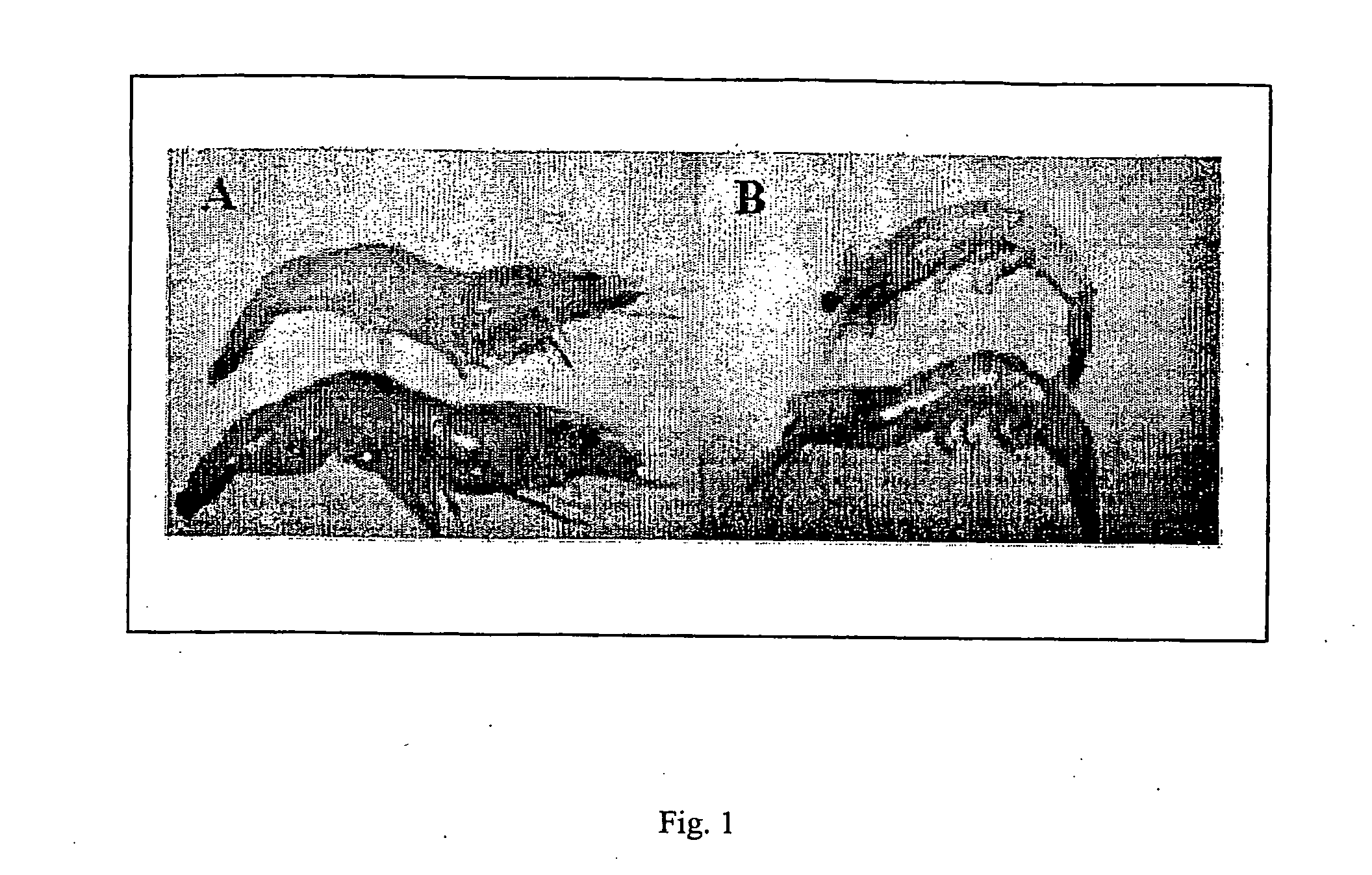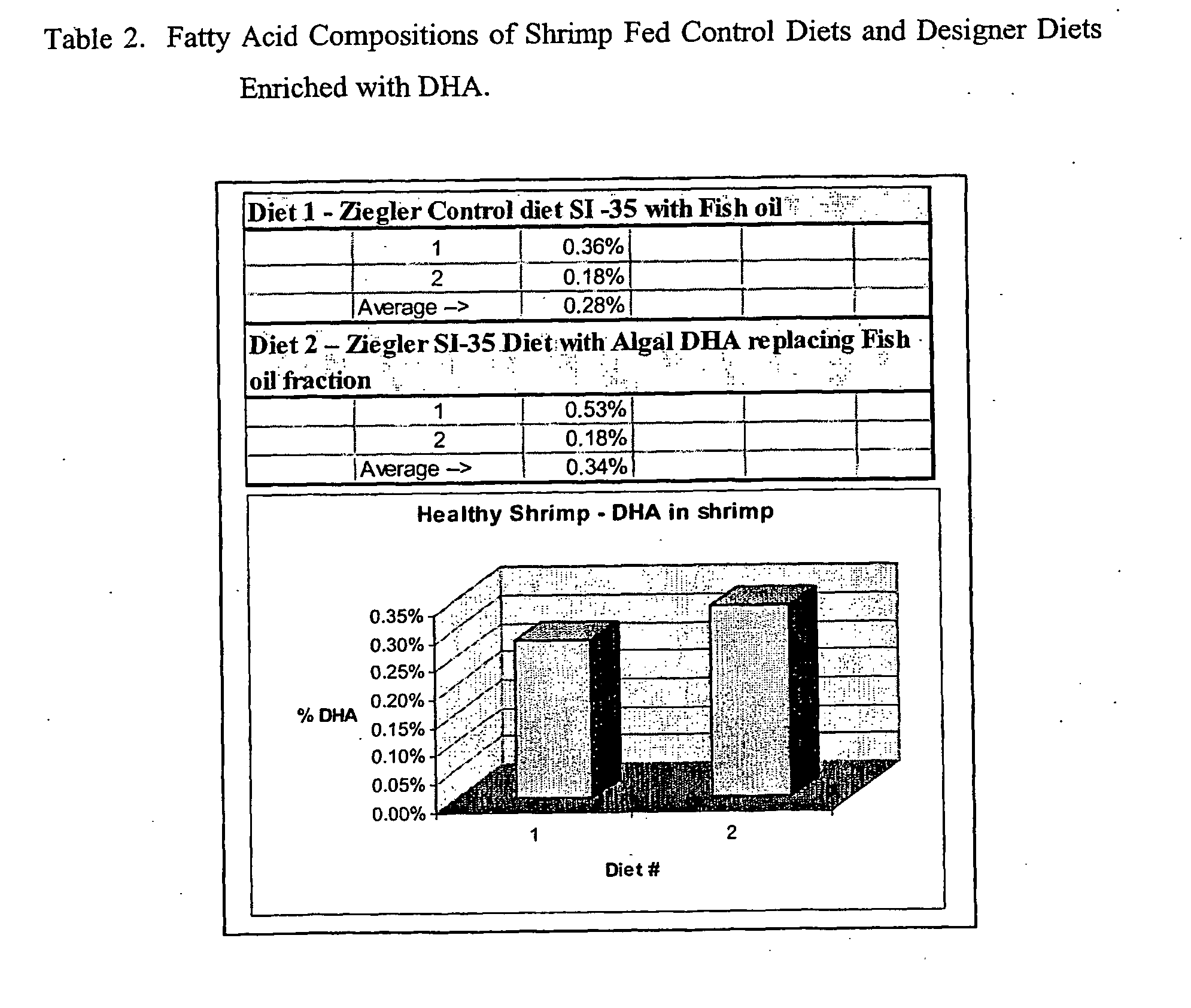Shrimp and the production thereof
a technology of shrimp and aquaculture, applied in the field of shrimp raised in aquaculture, can solve the problems of subtle differences in shrimp's taste, unsatisfactory nutritional attributes for humans, and even greater taste problems of freshwater shrimp
- Summary
- Abstract
- Description
- Claims
- Application Information
AI Technical Summary
Benefits of technology
Problems solved by technology
Method used
Image
Examples
example 1
Production of Shrimp Containing High Levels of DHA
[0048] Standard intensive and self-contained, semi-intensive, or extensive shrimp production systems can be used (Leung and Moss 2000; Haws and Boyd 2001). Intensive, zero-water exchange systems are preferable to produce Organic or 100% Organic high-DHA shrimp (Leung and Moss 2000). Two weeks prior to harvest date, the feeding regimen of the shrimp is altered to provide a Finishing Feed, which comprises the standard shrimp grow-out feed, plus a supplement of DHA (25 g DHA / kg feed, or 50% of total fat) provided as 200 g Crypthecodinium sp. / kg feed (e.g., from AquaGrow Advantage; Advanced BioNutrition Corp., Columbia, Md.). Alternatively, 300 g Schizochytrium sp. / kg of feed (5% of total fat of feed) can be used (e.g., from Aquafauna BioMarine, Hawthorne, Calif.). The high-DHA shrimp are harvested using processes and practices known in the art.
[0049] The shrimp so produced can be used as a healthy replacement for wild-caught or aquacu...
example 2
Production of a High-Lutein Shrimp
[0050] Standard intensive and self-contained, semi-intensive, or extensive shrimp production systems can be used (Leung and Moss 2000; Haws and Boyd 2001). Intensive, zero-water exchange systems (Leung and Moss 2000) would be preferable to produce an “Organic” high-lutein shrimp. Two weeks prior to harvest date, the feeding regimen of the shrimp is altered to provide a “Finishing Feed” which comprises the standard shrimp grow-out feed plus a supplement of lutein (60 mg lutein / kg feed) provided as a standardized marigold extract (6 mg lutein / 100 mg oil) by the addition of 1 g marigold extract per kg feed. The high-lutein shrimp are harvested using processes and practices known in the art.
[0051] The shrimp so produced can be used as a healthy replacement for wild-caught or aquaculturally produced shrimp in any of the manners normally used to process shrimp including, but not limited to, steamed, cooked, cerveche, shredded, extruded, and dried.
example 3
Production of an Aquacultured Shrimp with Improved Flavor
[0052] Standard intensive and self-contained, semi-intensive, or extensive shrimp production systems can be used (Leung and Moss 2000; Haws and Boyd 2001). Intensive, zero-water exchange systems (Leung and Moss 2000) are preferable to produce an Organic high-lutein shrimp. Two weeks prior to harvest date, the feeding regimen of the shrimp is altered to provide a Finishing Feed which comprises the standard shrimp grow-out feed plus a Flavor Enhancer, such as 2,6-dibromophenol (10 mg 2,6-dibromophenol / kg feed), by the addition of the flavor enhancer directly to the feed prior to extrusion or by coating the feed with the flavor enhancer using spray coating techniques standard in the art. The shrimp are harvested using processes and practices known in the art and will have a taste similar to marine-raised sea shrimp.
[0053] The shrimp so produced can be used as a healthy replacement for wild-caught or aquaculturally produced shri...
PUM
 Login to View More
Login to View More Abstract
Description
Claims
Application Information
 Login to View More
Login to View More - R&D
- Intellectual Property
- Life Sciences
- Materials
- Tech Scout
- Unparalleled Data Quality
- Higher Quality Content
- 60% Fewer Hallucinations
Browse by: Latest US Patents, China's latest patents, Technical Efficacy Thesaurus, Application Domain, Technology Topic, Popular Technical Reports.
© 2025 PatSnap. All rights reserved.Legal|Privacy policy|Modern Slavery Act Transparency Statement|Sitemap|About US| Contact US: help@patsnap.com


